The Red Pill Problem: Conducting a visual network graph analysis using Gephi on Red Pill and Blue Pill Search Queries on YouTube.
Alexander Teggin, Emilie Schwantzer, Son Nguyen.
Keywords: Network Graph Analysis, Gephi, YouTube, Red Pill, Social Network

Abstract
During the last few years, the Red Pill movement has established strongholds on Youtube through a network of diverse channels promoting content ranging from anti-liberalism, anti-feminism to extreme right-wing political ideologies. Although the channels vary in quantities, they seem to share close thematic relationships. Using Youtube Data Crawl Netviz and Gephi data visualisation, we explored the dynamics of channels and videos from the search queries “Red Pill” and “Blue Pill”.
Introduction
A democratic society where widespread information is the norm is neither utopian nor progressive but potentially a breeding ground for conspiracy theories, toxicity, and extremism. Services such as YouTube, which allows the publication of audiovisual products with loosely enforced regulations, is an ideal platform for diverse communities, enabling culture production and the circulation of ideologies (Röchert 2, Herrman). Red Pill stands out among these ideologies as a loosely defined phenomenon equated to a codeword indicating neo-reactionary enlightenment associated with a wake from the false consciousness of liberal political correctness (Aikin 422, Benjamin 3). The term has roots in The Matrix (1999), taking inspiration from the scene when the character Neo chooses to take the Red Pill over the Blue Pill to awake from a simulated reality; however, when appearing in the context of Youtube, it can reference several ideas. Regarding these Red Pill vernaculars, the essay will first explain Red Pill as a phenomenon before using Youtube as a gateway to explore content associated with the Red Pill by visualizing it using Gephi.
Theoretical Background / Literature Review
Youtube is a space with conditions enabling users to create audiovisual content and circulate data around it. Röchert (2021) argued that Youtube afforded diverse communities in the forms of different individual channels but loosely and thematically related (2). Within this domain, the algorithm also plays a vital role as a tool to circulate similar content to consumers according to their viewing history (Gillespie 173). Through this mean, Red Pill managed to find a firm breeding ground within YouTube as a vernacular. De Zeeuw and others defined vernaculars as specific to a community but remain obscure to others outside the group (216). Under different contexts, these vernaculars are also meant to express wills and emotions towards particular issues. Similarly, in the case of Red Pills on Youtube, Tuters identified Red Pill memes specifically and Red Pill in general as a means of expression, meaning waking up from the false world, oriented towards a violent reaction against governing system of power (3).
Terminology
Having established one of the environments from which Red Pill stems, the question returns to what exactly is Red Pill. Cunha traced the term’s meaning back to The Matrix, taking the Pill to wake up from a false conscious society. From the term Red Pill, other vernacular terminologies are closely associated with the original phrase, which appears during the discussion sector of this text. In a general sense, the manosphere refers to the network of websites, blogs, forums that promote masculinity and strong opposition to modern feminism. A vital part of the manosphere is its members called incels, meaning males who fail to get a romantic or sexual partner. Within this, 1 percent is a metaphorical representation of the ideal goal for masculinity to achieve in terms of being the top ultra-rich in income and wealth. The Pick-Up Artist (PUA) is another term that falls under toxic masculinity, meaning the movement from man to seduce and achieve sexual success with women. Finally, in association with this term, coaching refers to training men in the “arts’ of seduction and manipulating women. All of these terms are specific vernaculars within the Red Pill toxic masculine environment.
Methodology
In the following section, we first describe why and how we selected the datasets and search queries from YouTube to analyse, including limitations and specifications on the tool used to scrape data from Youtube without including personal biases. Following this, we outline the method of translating the datasets into visual network graphs using Gephi. We also explain how the data was extrapolated from the YouTube Data Tools. Lastly, we look at different ways of using these values to help layout the network graphs to identify clusters of similar content or other notable patterns.
Video And Channel Search Module Parameters
In order to extract data from YouTube and build a network graph of Red Pill-related content, we used the Netvizz YouTube Data Tool Set to scrape results from different search queries and channel recommendations. In order to maintain a workable sample of data – and for ease of replication, we scraped both YouTube Channel and Video Modules with the Search Queries of ‘Red Pill’ and ‘Blue Pill’. Our findings focused on the Video Channel Module, which uses search results to allow for more easily accessible content than the networks of ‘featured channels’ found when scraping data via the Channel Network Module. The Video Network Module creates a “network of relations between videos, starting from a search or a list of video ids [to] generate a network of channels based on the same relations”. (YouTube Data Tools) More specifically, the scraping tool’s code targets the “related videos” dataset from the “search/list#relatedToVideoId” API endpoint and transforms this into a. PDF file format (YouTube Data Tools).
For this research project, we used the parameters of 5 iterations with a crawl depth of 1 (i.e. we scraped five iterations of 50 results each – with a depth of 1 which indicates how far from the seeded search query the script goes (YouTube Data Tools).
Network Analysis: Gephi Layout and Degrees
In order to visualise the video and channel search networks, we used a combination of modularity ranking and betweenness centralities – as these can help to visually demarcate specific clusters of similarity and influence potential, respectively. As Newman explains, the value of modularity is useful for identifying communities “a closely connected social community will imply a faster rate of transmission of information or rumour among them than a loosely connected community… [And] leads to the appearance of communities in a given network” (Newman 2007).
Node size was ranked according to the betweenness centrality, which detects the amount of influence a node has over the flow of information by looking at how many nodes are intercepted via a connection. Modularity was used to help partition the clusters into different colour groups for easier identification. Networks with high modularity have dense connections between nodes within modules but fewer connections with the nodes in other modules – i.e. they are closed communities or clusters of related actors. The algorithm used to work out the communities and modularities was developed by Blondel et al. l in the Journal of Statistical Mechanics: Theory and Experiment (2008).
Research Limitations
Overall, there are many limitations when dealing with network analysis, considering the quantity of data, multiple cross-platform contaminations, and the dynamic nature of fast-changing online platforms like YouTube. While more research and focus needs to be put into how networking analysis methodologies can be improved considering these challenges – we identified three primary limitations that influenced the scope and focus of our research.
a) Language limitations: Several videos, channels, and clusters identified in our research data are produced in multiple languages and dialects. Without extensive language resource tools, it is impossible to objectively deduce inferences about a large amount of the content – however, we can still infer geopolitical conclusions regarding which languages or dialects appear and how they are represented.
b) Limitations of ambiguity within large data sets. One of the biggest challenges when conducting any data research is the quantity and scope of the sample data used. With more resources, time, and computing power, it would be possible to deduce more correlations between the networked graphs and the specific video content relating to themes of Red Pill toxicity. Considering this, when working with large sets of social network metadata, we have to find alternative ways to infer possible meanings from the structures, clusters, and patterns of connections evident when visually translating the data into network graphs.
c) Lastly, there are also specific platform limitations present. These exist both within YouTube’s ecosystem – where some protocols regarding how videos are searched and sorted within their algorithms affect our overall graphs. While we cannot find a way to subvert this limitation to our research – it is essential to consider YouTube’s platform affects how the data is manifested and represented – while still trying to conclude both the producers, consumers, and ecosystem of YouTube. Another platform limitation that affects the sample size used is the current computer processing power available to our research. Because of the limited processing power and time for scraping data – sample sizes need to be kept smaller enough to analyse on accessible computers – yet still large enough to avoid non-uniform samples.
Findings



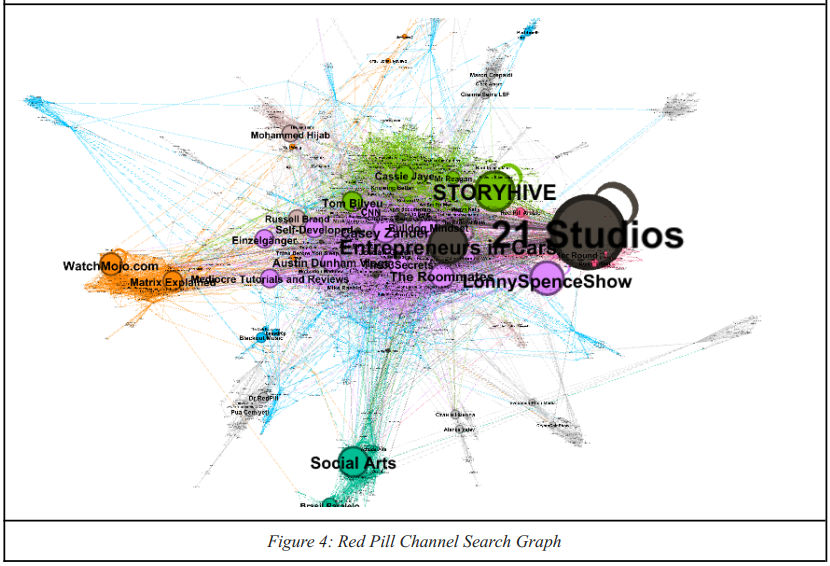
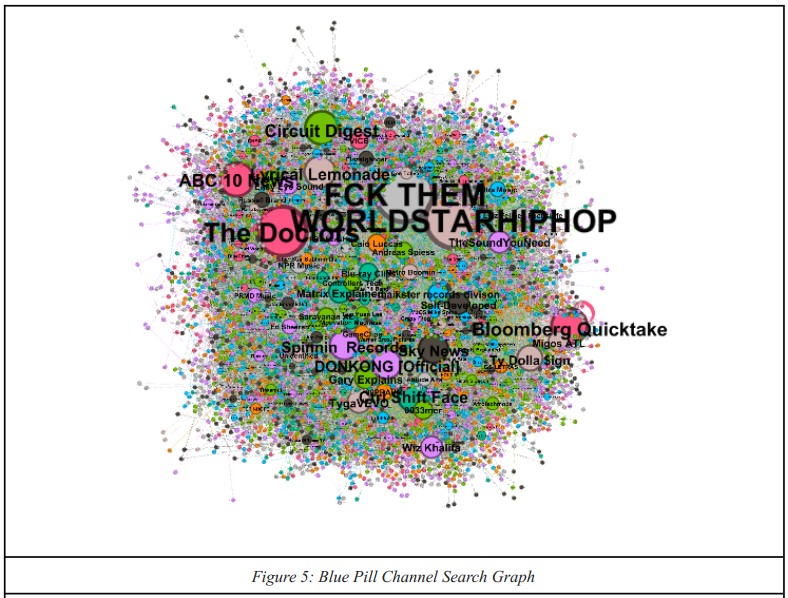

Red Pill Search Query
The modularity values as indicated by the different colors on the graph (refer to Figure 7) indicated 22 primary clusters. Not all 22 clusters will be discussed as it is visually apparent that some clusters are significantly larger than others. Clusters with a modularity class percentage of > 3% containing nodes with a betweenness centrality measure > 0 are for the purpose of this paper deemed influential.
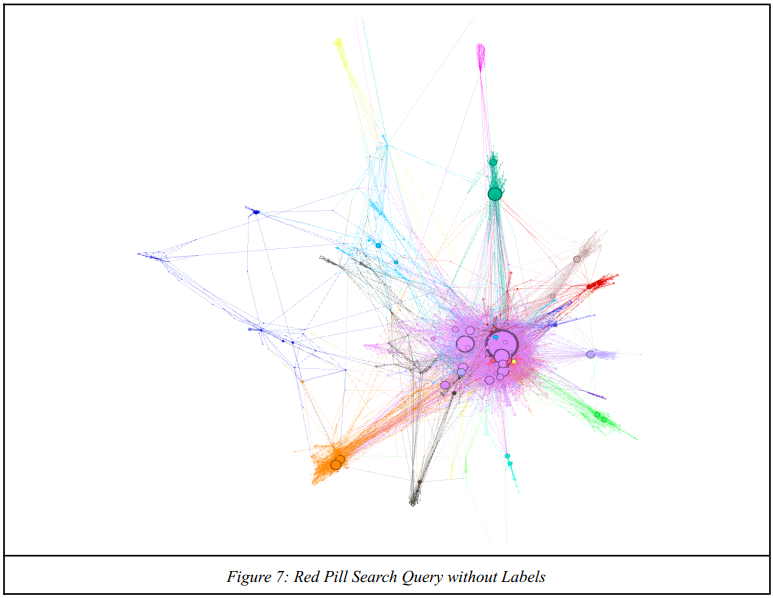
The Main Cluster
The most influential cluster is represented in pink, which will be labeled the main cluster. This represents the largest community of nodes making up 21 percent of the modularity class as well as containing the node with the highest betweenness centrality measure of 362336.66 (rounded to the nearest decimal point). These nodes within this cluster can be viewed as the most relevant and influential video channels when searching the term Red Pill on Youtube. This cluster represents the most influential nodes of both this cluster as well as the entire data set.
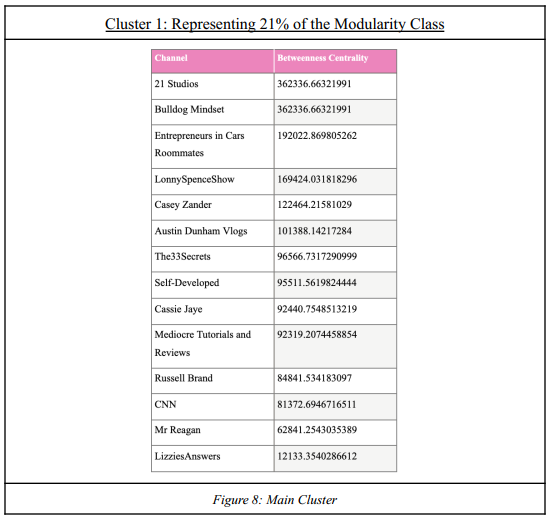
Red Pill Sub-Clusters
The remaining sub-clusters are represented by different colours (refer back to Figure 7). There are a total of 8 sub-clusters with a modularity class of over 3%. It is important to note that this does not mean the smaller clusters are unimportant to the entire network but are less influential. Upon closer analysis of the clusters that formed, it became evident that common themes were apparent among channels within a cluster. For example, five out of the eight sub-clusters had videos from the same region and generally were also from the specific language of that region. The tables below (refer to Figure 9) indicate the top 5 highest betweenness centrality channels within sub-clusters. The betweenness centrality measure is used in order to determine the relevancy of the channel to both the sub-cluster as well as to the overall dataset.
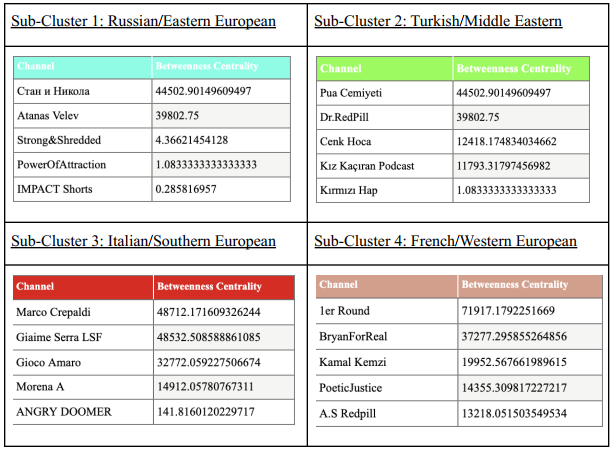
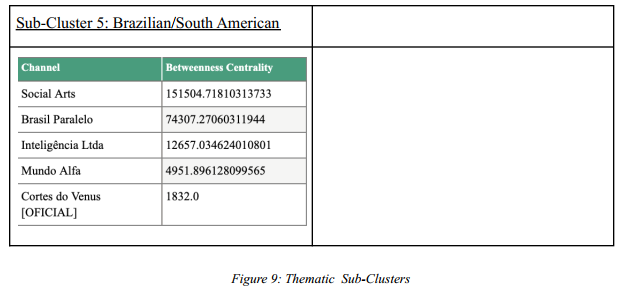
The last three clusters also had consistent themes running through the nodes. One cluster was dedicated to financial coaching videos and predominantly consisted of cryptocurrency and trading advice videos (refer to Figure 10). Another cluster comprised videos based on consciousness, truth, and spirituality. The last cluster is composed of film channels that were directly related to the Matrix content.
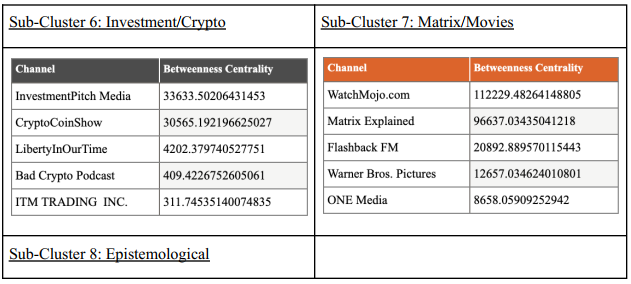
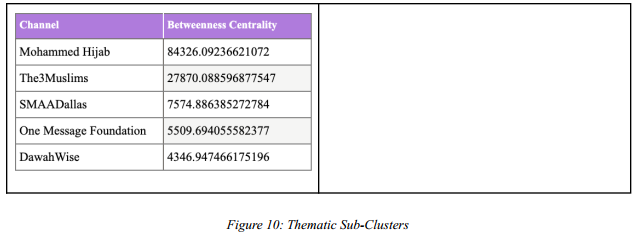
Discussion
The channel clusters mentioned previously are some of the most influential channels in the Red Pill search network. However small, these clusters represent an important portion of the Red Pill Youtube search query. From this information, it is possible to derive what the Youtube Red Pill vernaculars look like as well as what some channels individuals would likely stumble across when searching the term ‘Red Pill’.
A general overview of the video content within the clusters concludes that the most influential channels are American-based. All 14 channels pulled from the data set (refer to Figure 8: Main Cluster) are American channels targeted towards English-speaking audiences. That being said, the data reveals that the Red Pill influence extends beyond American communities as sub-red pill communities from other regions have formed. Although analysis of thumbnails can infer that there are prevalent themes. Figure 11 to 13 illustrates this as all three thumbnails all feature a picture of a man as wealthy with click-baiting, coaching titles.

Identity Formation based on Toxic Masculinity and Heteronormativity
Taking a closer look at the top 5 channels of the most relevant clusters gave us a sense of what the red-pill community on Youtube looks like. Within the videos, there is an overwhelming presence of videos dedicated to the improvement of the body and mind. This became evident with recurring keywords such as mindset, coaching, diet, and exercise. The theme of transcending and finding the ‘ultimate truth’ is evident in the prevalence of videos based on epistemology and religion. That is not to say that they are closely related but rather that they both fall under the theme of ‘awakening’. There seems to be the assumption that taking the Red Pill would result in some kind of higher power, strength, and success. This was revealed by looking closer at some of the sub-clusters. For example, the investment cluster revealed the link between financial success and being the “ideal” male. The ideal male in this case is referred to either as the 1 or 5 percent (refer to Figure 13), a term used by influential Red Pill Youtube Channels such as Fresh and Fit and Kevin Samuels. The 1 percent is a metaphorical representation of the ideal goal for masculinity to achieve in terms of being the top ultra-rich in income and wealth, in which a man becomes the ‘alpha’ male. The Red Pill claims that there is an ‘ultimate’ man commonly represented by the term ‘alpha male’. Somehow through metaphorically ingesting the Red Pill, you will reach a higher power by knowing how to speak to women, becoming physically fit and financially successful.
The ‘transformative’ theme of becoming the ‘alpha male’ is not only determined by a man’s financial success but also his physical strength and success with women. This is evident by the abundance of Pickup Artists (PUA’s) that are present within the clusters in the Graph.
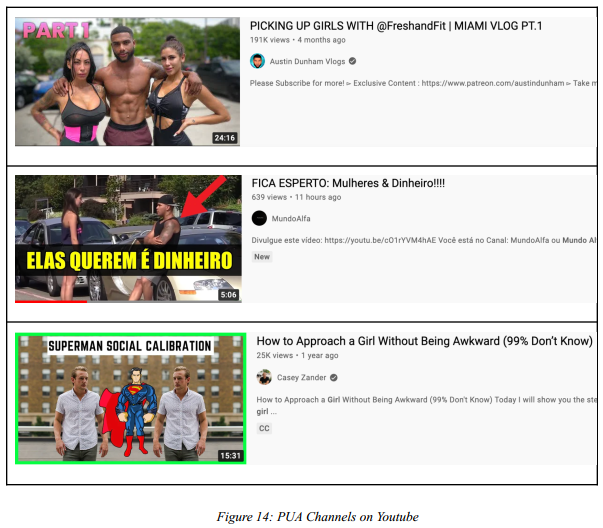
Some examples are Austin Dunham Vlogs, Mundo Alfa, and Casey Zander (refer to Figure 14) which all combine fitness content, relationship advice, and most prevalently cold approaching women in public spaces. This all falls under the illusion that financially successful, fit men are a ‘prize’. Subsequently, the transformation of the ‘beta’ male into the ‘alpha’ relies on heteronormative ideals of masculinity.
Subverting Red Pill Discussions
There are also groups of actors within the network that may not be promoting Red Pill content, but rather subverting, disproving, or debating their ideas. These types of Blue Pill, ‘pro-woke’ or centralist views are identifiable within clusters of the Red Pill video graph and can create difficulty making any absolute claims regarding clusters and potential toxic influence. This can also work vice versa – with red pill content being masked or disguised under other names – which creates research challenges when trying to identify specific clusters of influence.
As Röchert et all (2021) state: “exposure to conspiracy beliefs can occur even without being polarized or deliberately seeking information”. Furthermore, their research goes on to explain how it is important to be cognizant about the ambiguity of intention within YouTube datasets – as often titles, comments or metadata can be misleading or in reaction to ideas. As they explain:
“counter-messages are directly associated with extremist videos. .. [Users] who view counter-videos are likely to receive a recommendation for extremist videos” (Röchert et all 2021). Or in a similar way – users searching for Red Pill content may be served anti-Red Pill content and vice versa. A good example of how different actors subvert the toxic aspects of the Red Pill communities by using their same ideas can be seen in the ‘Red Pill Black’ movement by Candace Owens, which is a YouTube Channel that promotes black conservatism by using the term metaphorically for “the process of rejection of previously believed leftist narratives” (Ames 2007).
Conclusion
The research concludes that while the most influential Red Pill channels are mostly concentrated in the United States, its influence has reached other regions. Within these channels, the most prominent themes are toxic masculinity and heteronormativity where the acts of coaching men in romantic and sexual tactics with females with the goal to achieve a metaphorical “alpha-male” image are highly motivated.
Works Cited:
Aikin, Scott F. ‘Deep Disagreement, the Dark Enlightenment, and the Rhetoric of the Red Pill’. Journal of Applied Philosophy, vol. 36, no. 3, July 2019, pp. 420–35. DOI.org (Crossref), https://doi.org/10.1111/japp.12331.
Ames, Elizabeth. ‘Liberals Sick of the Alt-Left Are Taking “the Red Pill”’. Fox News, Fox News, 12 Sept. 2017, https://www.foxnews.com/opinion/liberals-sick-of-the-alt-left-are-taking-the-red-pill.
Ball, Siobhan. Lilly Wachowski Tells Musk and Invanka To ‘Fuck Off’ On Twitter. https://www.dailydot.com/unclick/lilly-wachowski-elon-musk-red-pill-fuck-off/.
Blondel Jean-Loup Guillaume, Renaud Lambiotte, and Etienne Lefebvre. ”Fast unfolding of communities in large networks.” Journal of Statistical Mechanics: Theory and Experiment, (10), 2008, pp. 1000
Cunha, Darlena. Red Pills and Dog Whistles: It Is More than ‘Just the Internet’. p. 2.
de Zeeuw, Daniël, and Marc Tuters. ‘Teh Internet Is Serious Business’. Cultural Politics, vol. 16, no. 2, July 2020, pp. 214–32. DOI.org (Crossref), https://doi.org/10.1215/17432197-8233406.
Gillespie, Tarleton. ‘The Relevance of Algorithms’. Media Technologies, edited by Tarleton Gillespie et al., The MIT Press, 2014, pp. 167–94. DOI.org (Crossref), https://doi.org/10.7551/mitpress/9780262525374.003.0009.
Herrman, John. ‘For the New Far Right, YouTube Has Become the New Talk Radio’. The New York Times, 3 Aug. 2017. NYTimes.com, https://www.nytimes.com/2017/08/03/magazine/for-the-new-far-right-youtube-has-become-the-new-talk-radio.html.
Lovink, Geert, et al. ‘Rude Awakening: Memes as dialectical images’. None (EN), Non.copyriot.com, 3 Apr. 2018. www.narcis.nl, https://research.hva.nl/en/publications/8df871b1-fedc-49dc-8159-a2bb23732a2f.
Newman, M. E. J. “Mathematics of networks”. The New Palgrave Encyclopedia of Economics (2 ed.). Palgrave Macmillan, Basingstoke (ed.), 2007.
Rieder, Bernhard (2015). YouTube Data Tools (Version 1.22) [Software]. Available from https://tools.digitalmethods.n et/netvizz/youtube/.
Röchert, Daniel, et al. ‘Caught in a Networked Collusion? Homogeneity in Conspiracy-Related Discussion Networks on YouTube’. Information Systems, vol. 103, Jan. 2022, p. 101866. ScienceDirect, https://doi.org/10.1016/j.is.2021.101866.
‘Search: List | YouTube Data API’. Google Developers, https://developers.google.com/youtube/v3/docs/search/list..
YouTube Data Tools. https://tools.digitalmethods.net/netvizz/youtube/mod_videos_net.php.